Monstera, a tropical vine belonging to the Araceae family, is a popular houseplant known for its large, glossy leaves with distinctive holes or splits. Adaptable to various light and humidity levels, this low-maintenance plant can purify the air in your home. Training your Monstera to climb not only replicates its natural habitat but also promotes larger and more fenestrated leaves, creating a stunning vertical display.
In this article, you’ll learn about the process of training a Monstera to climb, including choosing the right support system, location, and time, preparing the plant, attaching it to the support, and caring for it. Our main goal is to guide you through the process, offering tips and examples to ensure your Monstera thrives and becomes a beautiful focal point in your home.
Key Takeaways
- Training a Monstera to climb replicates its natural habitat and promotes healthier growth
- Choose the right support system, location, and time to begin training your Monstera
- Prepare your Monstera and properly care for it during and after the training process
Do Monsteras Like to Climb?
Monsteras are natural climbers that thrive in their native rainforest environment. In the wild, these plants use their aerial roots to attach themselves to trees or other structures, allowing them to reach for the light source and improve air circulation around them. As they grow, monsteras seek vertical support to reach higher levels of light and air, enhancing their overall health and appearance.
As you care for your monstera at home, it’s important to provide some form of climbing support. While monsteras can grow without it, they won’t reach their full potential in terms of size, shape, and fenestration of their leaves. By offering your monstera a structure to climb, you help it maintain its natural climbing instincts and promote healthier growth patterns.
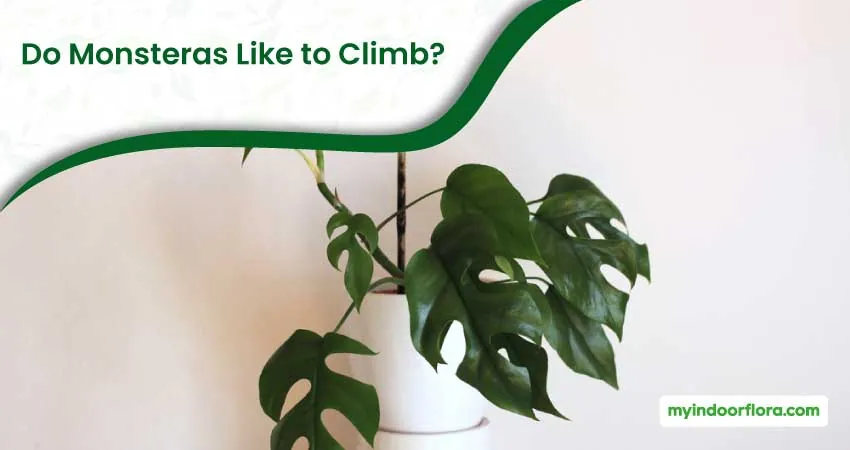
Climbing support can come in a variety of forms, such as moss poles, coco coir poles, trellises, or stakes. Each option serves the same purpose – allowing your monstera to grow vertically as it would in its native habitat. By encouraging your monstera to climb, you’ll not only support its natural growth instincts but also enhance its overall health and appearance. So, to answer the question, monsteras do indeed like to climb, and giving them the opportunity to do so will help your plant thrive.
Why Your Monstera Needs Support to Climb?
Your Monstera needs support to climb because its natural tendency is to grow upwards towards sunlight, mimicking its tropical jungle habitat. In the wild, Monsteras use their aerial roots to climb up trees for support, allowing them to reach better sunlight and avoid getting trampled by animals. Providing a support structure, such as trellises or moss poles, can help replicate this natural environment for your indoor Monstera.
One reason your Monstera needs support is that it does not have strong stems or tendrils that can wrap around objects like other vines. By providing a support structure, you can encourage your Monstera to grow upwards instead of sprawling out, ultimately helping it develop large, healthy leaves.
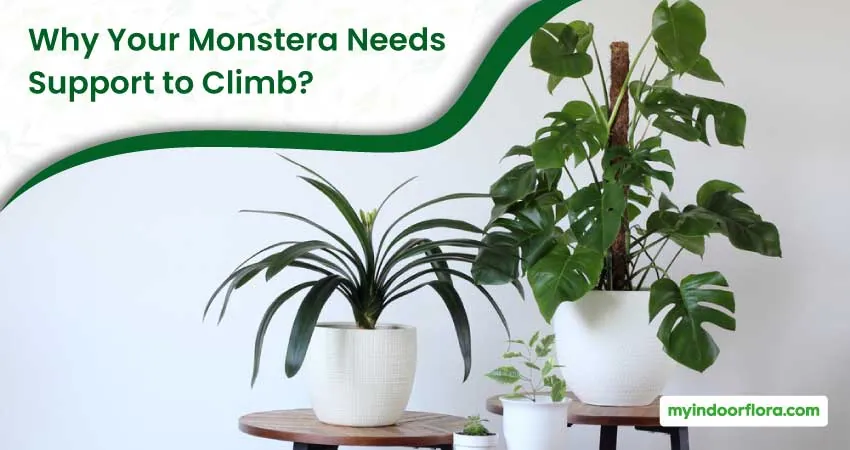
As your Monstera grows taller and produces larger leaves, it can become top-heavy and unstable. A support structure helps to prevent this issue, keeping your Monstera securely in place and allowing it to continue growing vertically without bending or breaking under its own weight.
Lack of proper support could result in your Monstera developing leggy or sparse growth if it does not receive enough light or space. By training your Monstera to climb, you can ensure it has adequate access to light and room for growth, which ultimately results in lusher foliage.
Additionally, a supported Monstera can enhance its photosynthesis and transpiration by exposing more leaf surface area to light and air. This leads to improved overall health and growth of the plant. So, investing in a suitable support structure and properly training your Monstera to climb can help your plant thrive, adding a beautiful touch of tropical jungle to your living space.
Types of Support Systems for Monstera
Moss Poles
Moss poles are one of the most popular support systems for Monstera plants. Typically made from sphagnum moss, these poles mimic their natural environment, providing an ideal place for their aerial roots to latch onto. Moss poles help encourage vertical growth and keep the plant healthy. To install a moss pole, simply insert it into your Monstera’s pot and gently guide the plant’s stems towards it.
Bamboo Stakes
Another option for supporting your Monstera is to use bamboo stakes. Bamboo is a sturdy and lightweight material that can effectively help your plant grow tall and lush. To use bamboo stakes, place them in the pot of your Monstera, and secure the stems to the stakes using soft ties or clips. Be careful not to damage the plant when attaching it to the stakes.
Read More: Mostera Staking
Coir Poles
Coir poles are an eco-friendly alternative to moss poles, made from coco coir. These poles not only provide support for your Monstera but also hold moisture, promoting healthy root growth. To utilize a coir pole, insert it into the pot, and guide your Monstera’s stems towards it, allowing them to wrap around and climb the pole.
Wire Structures
Wire structures, such as metal cages or grids, can also serve as a support system for your Monstera. These structures provide a more rigid framework for the plant to climb on, ensuring stability as it grows taller. To use a wire structure, place it in or around the pot, and gently guide the plant’s stems onto it, securing them as needed.
Trellis Structures
Trellis structures are another way to support your Monstera. These can be made of wood or metal and can be freestanding or wall-mounted. A trellis offers a flat surface for your Monstera to climb on, allowing it to spread out as it grows vertically. To use a trellis, position it near your plant, and gently attach the stems to the structure, guiding the plant as it grows.
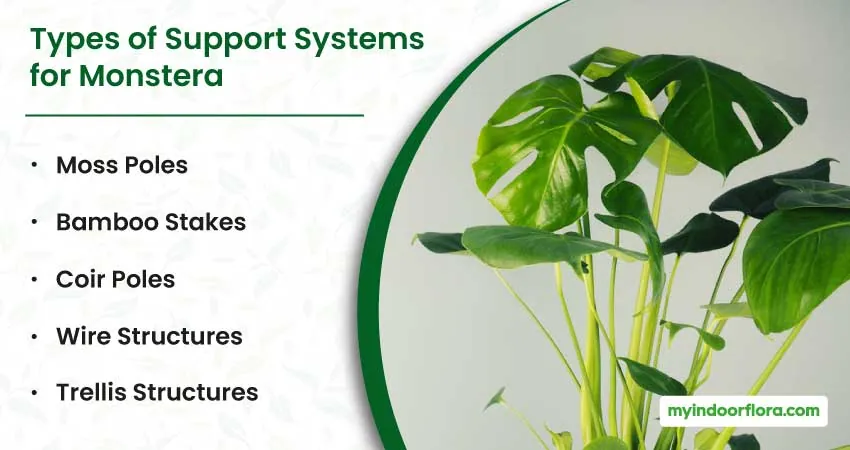
When Is It Time to Add A Support To Your Monstera?
There is no definitive answer to when it’s time to add a support to your Monstera, but there are some signs that indicate your plant may benefit from one.
- Taller than its current pot or container: If your Monstera has grown taller than its current pot or container, it might be time to provide a support. This will help encourage upward growth and prevent unbalanced development.
- Aerial roots: Your Monstera might start producing aerial roots that reach out for something to cling onto. This is another clear sign that your plant is ready for a support system.
- Large or heavy leaves: As your Monstera matures, it develops larger leaves which can sometimes droop or bend over. Adding a support can help prevent this, ensuring that the plant’s growth remains healthy and upward.
- Leggy or sparse growth: If your Monstera has become leggy or sparse due to lack of light or space, a support can help promote fuller growth and make your plant look more attractive.
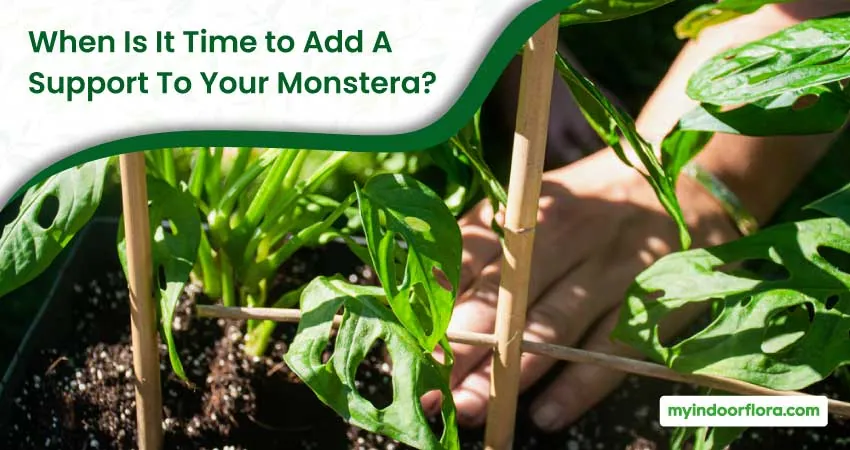
It’s better to add a support sooner rather than later, as it will be easier to train your Monstera when it is young and flexible. However, it is also possible to add a support later on if you missed the optimal time. Just be more careful and gentle when handling your Monstera to avoid causing any damage to the plant during the process. Remember to be patient and attentive with your Monstera, and enjoy watching it grow and thrive with the help of proper support.
Choosing the Right Location for Your Climbing Monstera
Choosing the right location for your climbing Monstera is crucial for its health and growth. The ideal spot should mimic its natural habitat and provide the necessary elements for the plant to thrive. Let’s discuss the characteristics you need to consider when selecting the perfect location for your indoor Monstera plant.
Firstly, it’s essential to provide your Monstera with bright, indirect light that is consistent and sufficient for photosynthesis. Place your plant near a light source where it can receive filtered sunlight for 5 to 8 hours a day. Avoid direct sunlight, as it can damage your plant’s leaves.
The second factor to consider is temperature and humidity. Monsteras thrive in warm and humid environments, similar to their tropical habitat. Ensure that your plant is placed in an area with consistent temperatures and humidity levels, away from cold drafts, heaters, or vents that can negatively impact its growth.
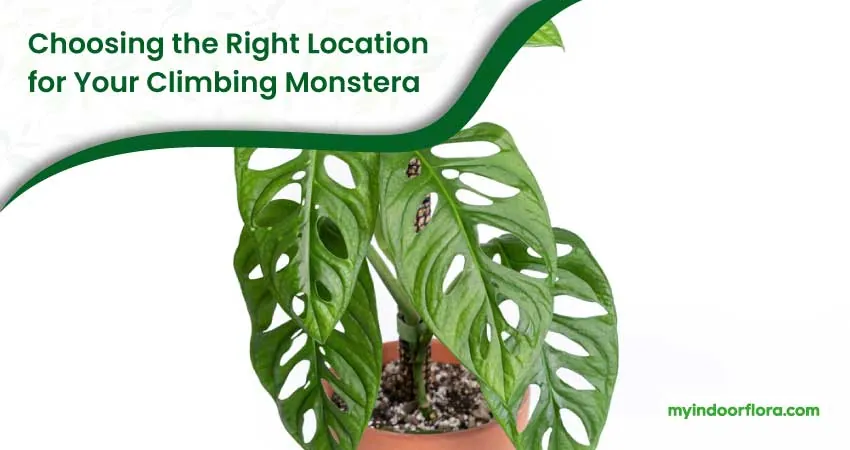
Next, make sure there is enough space and clearance for your climbing Monstera to grow vertically and horizontally. This allows it to properly attach itself to supports, like stakes or moss poles, promoting healthy growth.
Lastly, remember that conditions may change throughout different seasons. Be prepared to adjust the location of your climbing Monstera according to seasonal variations, the size of your plant, or the type of support system you use. Keep an eye on your plant’s progress and make the necessary adjustments to help it thrive in its new location.
By considering these factors and creating a suitable environment for your climbing Monstera, you’re setting your indoor plant up for success and optimal growth.
Preparing Your Monstera for Training
Preparing your Monstera for training is an essential step to ensure a smooth and successful process. By following these steps, you can set your Monstera on the right path to climb and thrive.
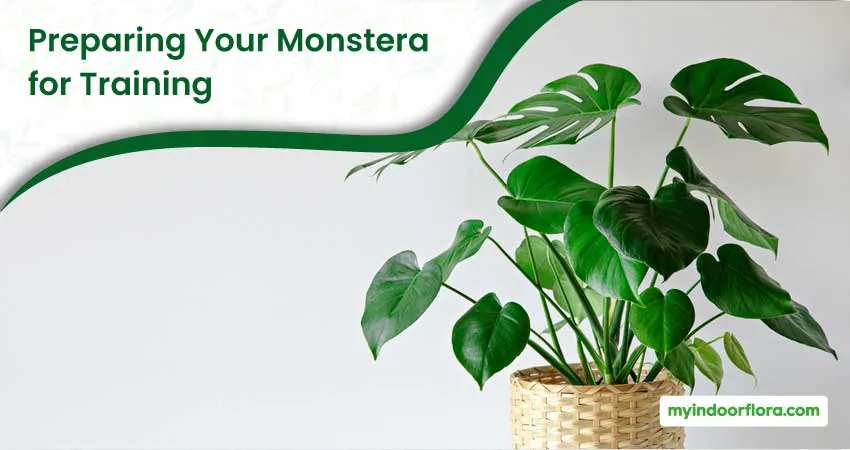
Step 1: Water your Monstera – Water your Monstera thoroughly a day before you start training it. This will make the roots and stems more pliable and easier to manipulate during the training process.
Step 2: Prune your Monstera – Remove any dead, damaged, or diseased leaves or stems that may interfere with the training process or affect the health of the plant. Pruning your Monstera will encourage healthy growth and make it easier for the plant to focus on climbing.
Step 3: Clean your Monstera – Wipe or dust off any dirt, dust, or pests that may have accumulated on the leaves or stems. This will ensure a clean surface for your Monstera to absorb light and air effectively.
Step 4: Gather your materials and tools – Before beginning the training process, gather the necessary materials and tools. These may include a support system (such as a moss pole, coco coir pole, or stakes), plant ties or wires, scissors or pruners, gloves, and a tarp or newspaper to cover your work area.
Now that your Monstera is prepared, you’re ready to start the training process. Good luck, and may your Monstera climb to new heights!
Step-by-Step Guide to Train Your Monstera to Climb
Attaching to Support
To train your Monstera to climb, first choose a support system such as a moss pole, bamboo stake, trellis, or even a wall. Insert or attach your support to your Monstera’s pot or container, making sure it is stable and secure. When using a moss pole, push it into the soil as close as possible to the main stem without damaging the roots. For a trellis, attach it to the wall or furniture behind your Monstera’s pot using nails, screws, hooks, or adhesive strips. Once your support is in place, gently guide your Monstera’s stems or vines towards the support system.
Watering and Fertilizing
Keep your Monstera healthy and hydrated so its aerial roots can climb the support system. Water your plant thoroughly when the top two to three inches of the soil feels dry to the touch. Additionally, providing your Monstera with nutrients through a balanced fertilizer encourages growth and helps aerial roots develop. Apply fertilizer according to the product’s guidelines, typically every few weeks during the growing season.
Providing Proper Lighting
To encourage climbing, make sure your Monstera gets adequate light. Place your Monstera in a spot with bright, indirect sunlight, as direct sunlight can burn its leaves. You can also use an artificial light source if necessary. The appropriate lighting ensures proper growth, allowing your Monstera to climb onto its support structure.
Regular Pruning
Pruning your Monstera helps direct energy towards growth and support, ensuring that it climbs the support system effectively. Focus on removing any weak, brittle, or damaged stems and leaves. By concentrating your plant’s energy on healthy stems, your Monstera will be more likely to climb efficiently and reach its full potential.
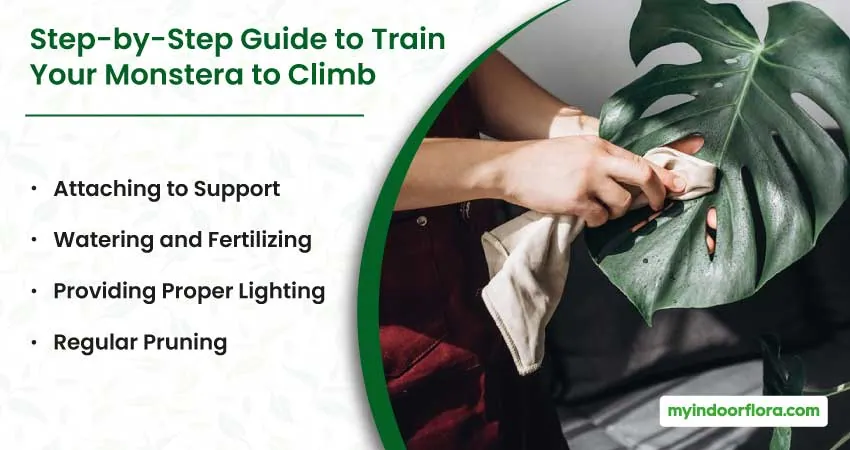
Ongoing Care for Your Climbing Monstera
Caring for your climbing Monstera is quite similar to taking care of a regular Monstera, but with some additional considerations to ensure its healthy growth. Here are some tips for the ongoing care of your climbing Monstera:
Watering: Be mindful of your Monstera’s water needs. Water the plant when the top inch of soil feels dry to the touch, but avoid overwatering, as this can cause root rot. Make sure to adjust watering frequency based on the season, as it may need less water during colder months.
Humidity: Monsteras thrive in high humidity environments. Use a spray bottle to mist your climbing Monstera’s leaves regularly to maintain humidity and keep the foliage looking fresh and glossy.
Light: Provide your climbing Monstera with bright, indirect light to support its growth. Avoid direct sunlight, as this can cause the leaves to burn.
Moss Poles: Ensure that your Monstera has adequate support for healthy growth. Moss poles or sturdy stakes can be used to help the plant climb and offer additional structural support.
Fertilizing: Feed your climbing Monstera with a balanced liquid fertilizer diluted to half strength, once a month during the spring and summer months. This will promote strong growth and keep your plant healthy.
Maintenance: Pruning your climbing Monstera helps maintain its shape and size. Remove any dead or damaged leaves and stems to promote overall plant health and give it a polished appearance.
Pest and Disease Control: Regularly inspect your climbing Monstera for any signs of pests or diseases. If you spot any issues, treat them promptly using organic remedies to keep your plant healthy and thriving.
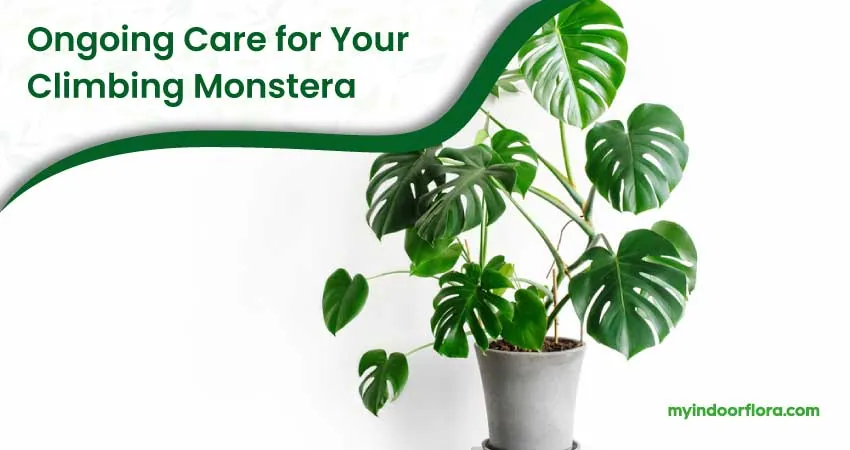
By following these care tips, you’ll be well on your way to keep your climbing Monstera happy, healthy, and growing strong.
Troubleshooting Common Problems
Sometimes when training your Monstera to climb, you may encounter a few common issues. Here are some tips to help you address these problems and maintain a healthier plant:
Stems not attaching to the support system: If your Monstera’s aerial roots are not long or strong enough to grip the support system, try moistening the support system and the aerial roots. You can also wrap them more securely with plant ties or wires. Adding some sphagnum moss or coconut coir to the support system can also provide extra grip.
Curling or wilting leaves: This could be due to your Monstera not receiving enough water, light, or humidity. To help your plant, water it more frequently, move to a brighter spot, or increase humidity by misting it more often.
Yellowing or browning leaves: Overwatering, excessive light, or too much fertilizer could cause this issue. To address this, try watering your Monstera less frequently, moving it to a shadier spot, or reducing the amount or frequency of fertilizer application.
In order to ensure a healthier plant while training it to climb, make sure to stay attentive to its needs. Regularly check the potting soil and adjust nutrients, sunlight, and watering schedules as necessary.
If your Monstera continues struggling, consider repotting it. Choose a slightly larger pot with fresh potting soil, ensuring proper drainage. This will provide more room for your Monstera to grow and reduce the chances of further damage.
Frequently Asked Questions
What type of support is best for Monstera?
There are several types of support that work well for Monsteras. A popular choice is a moss pole, which replicates their natural jungle habitat. Stakes made of bamboo or metal are also useful for smaller plants or those not requiring significant support. Trellises and wire meshes can provide a sturdy climbing structure for your Monstera, too.
How do I guide my Monstera to climb a pole?
To help your Monstera climb a pole, gently wrap its vines around the support, being careful not to damage the plant. You can also use soft raffia or pieces of string to loosely tie the vines to the support, making sure it’s not too tight. As the vines continue to grow, they will naturally start twining themselves around the support.
How to make a DIY climbing pole for Monstera?
To create a DIY climbing pole for your Monstera, gather a PVC pipe or wooden dowel rod and some sphagnum moss. Wrap the moss around the pipe or rod, covering it completely. Secure the moss in place with fishing line, garden twine, or zip ties. Place the DIY pole into the pot alongside your Monstera, making sure it’s stable, and guide your plant to climb it as described earlier.
How can I help my climbing Monstera grow better?
To help your climbing Monstera grow better, provide it with an environment that mimics its natural habitat. This includes proper temperature, humidity, and lighting conditions. Additionally, make sure to water and fertilize your Monstera according to its needs. Proactively monitoring and fulfilling these requirements will ultimately result in a healthier, more vibrant plant.
How to attach a Monstera to a moss pole?
To attach your Monstera to a moss pole, begin by placing the pole in the pot alongside your plant. Gently wrap the vines around the moss pole, taking extra care to avoid damaging them. You can also use soft raffia or string to loosely tie the vines to the pole, giving them the support they need to climb upwards. Over time, the aerial roots of the Monstera will naturally attach to the moss.
What should I do with the aerial roots of Monstera?
Aerial roots are a natural part of Monstera’s growth. In their natural environment, they cling to tree trunks or other surfaces for support. When growing Monstera indoors, allow the aerial roots to attach themselves to the support structure provided, such as a moss pole or trellis. If some aerial roots are left unattached, you can simply let them be, as they won’t cause any harm to the plant.
